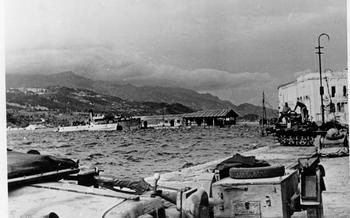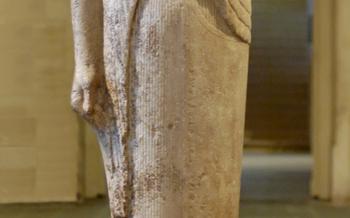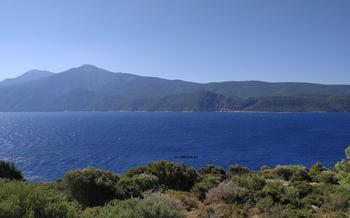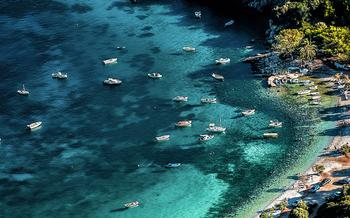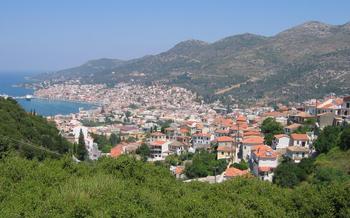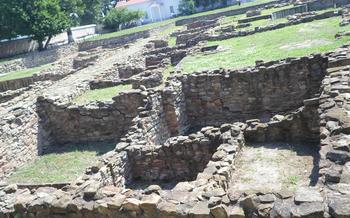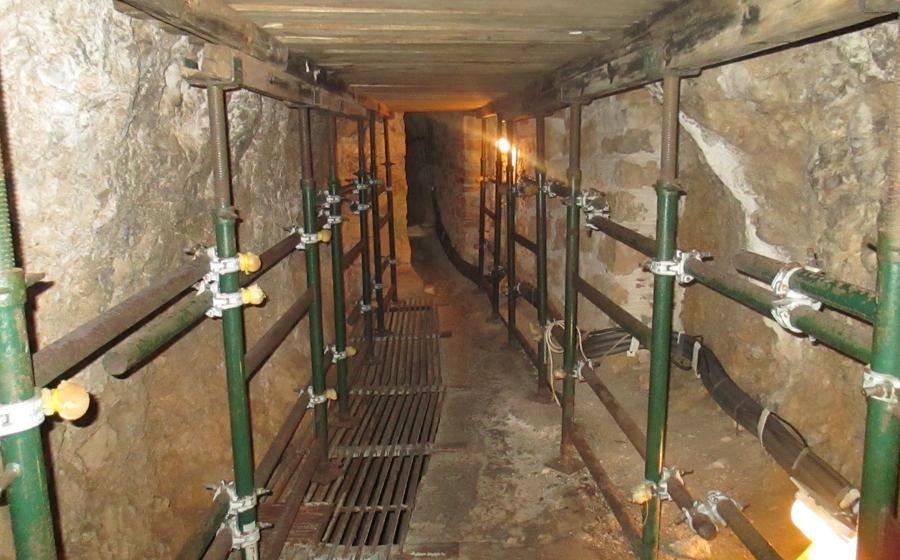
Tunnel of Eupalinos
- Historical Significance
- Location: Finding the Tunnel of Eupalinos
- Guided Tours
- Interior Features
- History of Eupalinos
- Ancient Water Management System
- Engineering Marvels
- Historical Context
- Legends and Myths
- UNESCO World Heritage Site
- Nearby Attractions
- Planning Your Visit
- Local Cuisine and Hospitality
- Insider Tip: The Secret Spring of Mytilini
Historical Significance
The Tunnel of Eupalinos stands as a testament to the ingenuity and perseverance of the ancient Greeks. Constructed around 550 BC on the Greek island of Samos, this remarkable engineering feat was designed to provide a reliable water supply to the ancient city of Samos. The tunnel, measuring approximately 1,036 meters in length, was carved entirely by hand using primitive tools and techniques. The precision and accuracy achieved in its construction are truly astonishing, especially considering the limited resources available at the time. The tunnel's construction required careful planning and coordination, demonstrating the advanced engineering skills possessed by the ancient Greeks. It remains a marvel of ancient engineering and a source of inspiration for modern engineers and architects.
Location: Finding the Tunnel of Eupalinos
The Tunnel of Eupalinos is nestled in the picturesque village of Pythagoreion, which lies on the southeastern coast of Samos. To reach the tunnel, you can embark on a scenic drive from the island's capital, Vathy, which takes approximately 45 minutes. Alternatively, if you're staying in nearby towns like Kokkari or Karlovassi, the journey will take around 20 minutes by car.
Once you arrive in Pythagoreion, follow the signs leading to the tunnel, which is situated just a short walk from the village center. You can conveniently use the village as your base, as it offers a range of accommodation options and charming tavernas serving traditional Greek cuisine.
Guided Tours
Taking a guided tour of the Tunnel of Eupalinos is an enriching experience that allows visitors to delve deeper into the history, construction, and significance of this ancient marvel. Reputable tour operators, such as the Samos Archaeological Museum and licensed local guides, offer guided tours of the tunnel. These tours typically cover the history of Eupalinos, the engineering techniques used, and the importance of the tunnel in ancient Samos. The cost of guided tours varies depending on the operator and the duration of the tour, but generally ranges from €10 to €20. Guided tours typically last for about an hour, providing ample time to explore the tunnel and learn about its fascinating history.
Interior Features
The Tunnel of Eupalinos is not just an impressive feat of engineering; it's also a captivating sight to behold. The sheer size and scale of the tunnel are awe-inspiring, standing as a testament to the ingenuity and perseverance of the ancient Greeks. As you venture into its depths, you'll marvel at the meticulously carved walls, each chisel mark telling a story of the immense labor that went into its construction. The tunnel's most striking feature is perhaps the water channel that runs through its center, a testament to the ancient Greeks' mastery of water management. This channel once carried fresh water from a nearby spring to the ancient city of Samos, ensuring a reliable water supply for its inhabitants.
History of Eupalinos
Eupalinos of Megara, the mastermind behind the Tunnel of Eupalinos, was a renowned architect and engineer who lived in the 6th century BC. He hailed from the ancient city of Megara, located in central Greece. Eupalinos's exceptional talent and expertise in engineering earned him a distinguished place among the greatest minds of his time.
Beyond the Tunnel of Eupalinos, Eupalinos is credited with several other remarkable engineering feats. He designed and constructed an aqueduct in Megara, demonstrating his mastery of water management and distribution systems. His contributions to the field of architecture extended to the construction of temples and other significant structures, showcasing his versatility and range as a builder.
The legacy of Eupalinos endures as a testament to his ingenuity and the remarkable engineering achievements of ancient Greece. His innovative techniques and solutions to complex challenges have left an indelible mark on the history of engineering and continue to inspire modern-day engineers and architects.
Ancient Water Management System
The Tunnel of Eupalinos stands as a testament to the ingenuity of ancient Greek engineers and their mastery of water management. In ancient Greece, access to a reliable water supply was essential for the survival and prosperity of any city. Samos, with its strategic location and growing population, faced challenges in meeting its water needs.
The construction of the tunnel addressed this critical issue by providing a reliable and efficient water supply to the city of Samos. By diverting water from a nearby spring, the tunnel ensured a steady flow of fresh water, even during periods of drought. This innovative solution not only solved the city's water scarcity problem but also revolutionized water management practices in the ancient world.
The tunnel's design facilitated efficient water flow through a series of carefully calculated slopes and channels. The water entering the tunnel from the spring was directed towards the city through a terracotta pipeline, ensuring a continuous supply of clean water. This sophisticated system demonstrated the advanced engineering knowledge of the ancient Greeks and their ability to harness natural resources for the benefit of their communities.
Engineering Marvels
The Tunnel of Eupalinos stands as a testament to the ingenuity and engineering prowess of the ancient Greeks. Constructed using rudimentary tools and techniques, the tunnel showcases innovative engineering solutions that were far ahead of their time.
The most remarkable aspect of the tunnel is its precise alignment. Despite being dug from opposite ends of the mountain, the two sections met with remarkable accuracy, with a deviation of less than two meters. This precision was achieved through meticulous surveying and the use of simple but effective leveling devices.
The tunnel's construction also involved overcoming significant geological challenges. The builders encountered hard rock formations that required specialized tools and techniques to penetrate. They also had to contend with groundwater seepage, which they cleverly diverted through a system of channels and drains.
The Tunnel of Eupalinos is not just an ancient engineering marvel but also a testament to the perseverance and determination of the ancient Greeks. Faced with seemingly insurmountable challenges, they displayed remarkable resilience and resourcefulness to complete this ambitious project.
Its construction techniques and engineering solutions have influenced modern engineering practices and continue to be studied and admired by engineers and historians alike. The tunnel serves as a reminder of the remarkable achievements of ancient civilizations and their enduring impact on our world.
Historical Context
To fully appreciate the significance of the Tunnel of Eupalinos, it's essential to understand the historical context of Samos. The island has a rich and storied past, dating back to ancient times. In the 6th century BC, Samos was a powerful and prosperous city-state, renowned for its wealth, trade, and cultural achievements. The construction of the tunnel was a testament to the ingenuity and ambition of the Samians, who sought to secure a reliable water supply for their growing population.
Strategically located in the northeastern Aegean Sea, Samos occupied a crucial position in the ancient world. Its proximity to major trade routes and its fertile lands made it a desirable prize for conquest. The tunnel played a vital role in defending the city against potential invaders. By diverting the water source outside the city walls, the Samians ensured that their enemies could not easily cut off their water supply during a siege. The tunnel thus became a strategic asset, safeguarding the independence and prosperity of Samos.
The construction of the tunnel also had a profound impact on the development of the island. The reliable water supply facilitated the expansion of agriculture and the growth of the population. Samos became a major exporter of agricultural products, further bolstering its economy and influence. The tunnel's legacy extended beyond Samos itself, inspiring other ancient Greek cities to undertake ambitious engineering projects to secure their water supplies.
Legends and Myths
The Tunnel of Eupalinos has inspired a myriad of local legends and myths over the centuries, adding to its allure and mystique. One captivating tale narrates how Eupalinos, determined to secure funding for his ambitious project, resorted to a clever ruse. He promised the skeptical Samians that he could build the tunnel in just one day. To their astonishment, Eupalinos worked tirelessly throughout the night, using lanterns to illuminate his path. By dawn, he had indeed completed a significant portion of the tunnel, convincing the Samians of his extraordinary abilities and securing their support for the project.
Another enchanting myth entwines the tunnel with the Greek goddess Artemis. Legend has it that Artemis, revered as the protector of Samos, was instrumental in guiding Eupalinos during the construction of the tunnel. She is said to have appeared to him in dreams, offering guidance and protection as he navigated the challenges of the project. Locals believe that Artemis's divine intervention ensured the successful completion of the tunnel and its enduring legacy.
UNESCO World Heritage Site
The Tunnel of Eupalinos holds a prestigious distinction as a UNESCO World Heritage Site. This designation recognizes its exceptional universal value and cultural significance. The tunnel meets several criteria set by UNESCO, including being an outstanding example of ancient engineering and hydraulics. Its construction techniques and innovative design demonstrate the advanced skills and knowledge of the ancient Greeks.
The tunnel's inclusion on the World Heritage list highlights its global importance and the need for its preservation and protection. UNESCO's recognition ensures that the tunnel will continue to be celebrated and studied by future generations, serving as a reminder of the ingenuity and perseverance of our ancestors.
Nearby Attractions
In addition to the Tunnel of Eupalinos, Samos offers a wealth of other attractions that are sure to captivate your senses. The ancient city of Pythagoreion, a UNESCO World Heritage Site, boasts well-preserved ruins that transport you back in time. Explore the remains of the ancient harbor, the Temple of Hera, and the impressive fortifications that once protected the city.
Venture beyond the historical sites and immerse yourself in the island's natural beauty. Samos is home to stunning beaches with crystal-clear waters, inviting you to bask in the sun, swim, and snorkel amidst vibrant marine life. The island's mountainous terrain offers opportunities for hiking and trekking, where you can discover hidden waterfalls, lush forests, and breathtaking panoramic views.
Planning Your Visit
To make the most of your visit to the Tunnel of Eupalinos, careful planning is essential. The best time to experience the tunnel's wonders is during the shoulder seasons (spring and autumn) when the weather is pleasant, and the crowds are smaller. Summer months can be hot and crowded, while winter may bring occasional rainfall.
To avoid the worst of the crowds, aim to arrive early in the morning or late in the afternoon. Guided tours typically operate throughout the day, but self-guided exploration is also possible during opening hours. Remember to wear comfortable shoes and clothing suitable for walking on uneven surfaces. Bring a flashlight or headlamp to illuminate the tunnel's interior, as natural light is limited.
Plan to spend at least an hour exploring the tunnel and its surroundings. Take your time to admire the impressive construction, learn about its history, and soak in the unique atmosphere of this ancient marvel.
Local Cuisine and Hospitality
Samos is renowned for its delectable cuisine, a delightful blend of fresh, local ingredients and traditional Greek flavors. Indulge in mouthwatering dishes prepared with local herbs, succulent seafood, and the island's famous sweet Muscat wine. For an authentic culinary experience, head to the charming tavernas and restaurants in the picturesque villages of Samos. The warm hospitality of the Samian people will make you feel right at home as they welcome you with open arms and share their love of food and culture. During my visit, I had the pleasure of dining at a traditional Greek taverna, where I savored the flavors of freshly caught grilled octopus, accompanied by a glass of the local Muscat wine. It was an unforgettable experience that showcased the culinary delights and warm hospitality that Samos has to offer.
Insider Tip: The Secret Spring of Mytilini
After exploring the Tunnel of Eupalinos, take a short hike to discover the hidden gem of the Mytilini spring. Located just a few kilometers from the tunnel, this natural spring offers a refreshing oasis amidst the rugged landscape. Follow the path that leads from the tunnel's exit, and you'll soon find yourself surrounded by lush greenery and the sound of trickling water. Relax by the spring, enjoy a picnic lunch, and admire the stunning views of the surrounding hills. It's the perfect way to end your journey through this ancient engineering marvel.
